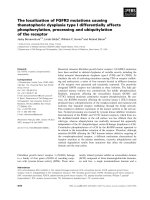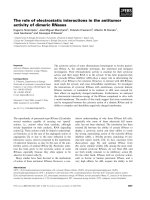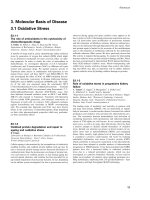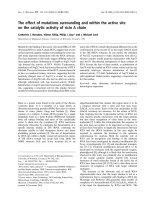Báo cáo khoa học: "The Prevalence of Descriptive Referring Expressions in News and Narrative" potx
Bạn đang xem bản rút gọn của tài liệu. Xem và tải ngay bản đầy đủ của tài liệu tại đây (94.24 KB, 6 trang )
Proceedings of the ACL 2010 Conference Short Papers, pages 49–54,
Uppsala, Sweden, 11-16 July 2010.
c
2010 Association for Computational Linguistics
The Prevalence of Descriptive Referring Expressions
in News and Narrative
Raquel Herv
´
as
Departamento de Ingenieria
del Software e Inteligenc
´
ıa Artificial
Universidad Complutense de Madrid
Madrid, 28040 Spain
Mark Alan Finlayson
Computer Science and
Artificial Intelligence Laboratory
Massachusetts Institute of Technology
Cambridge, MA, 02139 USA
Abstract
Generating referring expressions is a key
step in Natural Language Generation. Re-
searchers have focused almost exclusively
on generating distinctive referring expres-
sions, that is, referring expressions that
uniquely identify their intended referent.
While undoubtedly one of their most im-
portant functions, referring expressions
can be more than distinctive. In particular,
descriptive referring expressions – those
that provide additional information not re-
quired for distinction – are critical to flu-
ent, efficient, well-written text. We present
a corpus analysis in which approximately
one-fifth of 7,207 referring expressions in
24,422 words of news and narrative are de-
scriptive. These data show that if we are
ever to fully master natural language gen-
eration, especially for the genres of news
and narrative, researchers will need to de-
vote more attention to understanding how
to generate descriptive, and not just dis-
tinctive, referring expressions.
1 A Distinctive Focus
Generating referring expressions is a key step in
Natural Language Generation (NLG). From early
treatments in seminal papers by Appelt (1985)
and Reiter and Dale (1992) to the recent set
of Referring Expression Generation (REG) Chal-
lenges (Gatt et al., 2009) through different corpora
available for the community (Eugenio et al., 1998;
van Deemter et al., 2006; Viethen and Dale, 2008),
generating referring expressions has become one
of the most studied areas of NLG.
Researchers studying this area have, almost
without exception, focused exclusively on how
to generate distinctive referring expressions, that
is, referring expressions that unambiguously iden-
tify their intended referent. Referring expres-
sions, however, may be more than distinctive. It
is widely acknowledged that they can be used to
achieve multiple goals, above and beyond distinc-
tion. Here we focus on descriptive referring ex-
pressions, that is, referring expressions that are not
only distinctive, but provide additional informa-
tion not required for identifying their intended ref-
erent. Consider the following text, in which some
of the referring expressions have been underlined:
Once upon a time there was
a man, who had
three daughters. They lived in
a house and
their
dresses were made of fabric.
While a bit strange, the text is perfectly well-
formed. All the referring expressions are distinc-
tive, in that we can properly identify the referents
of each expression. But the real text, the opening
lines to the folktale The Beauty and the Beast, is
actually much more lyrical:
Once upon a time there was
a rich merchant,
who had three daughters. They lived in
a
very fine house and their gowns were made
of
the richest fabric sewn with jewels.
All the boldfaced portions – namely, the choice
of head nouns, the addition of adjectives, the use
of appositive phrases – serve to perform a descrip-
tive function, and, importantly, are all unneces-
sary for distinction! In all of these cases, the au-
thor is using the referring expressions as a vehi-
cle for communicating information about the ref-
erents. This descriptive information is sometimes
new, sometimes necessary for understanding the
text, and sometimes just for added flavor. But
when the expression is descriptive, as opposed to
distinctive, this additional information is not re-
quired for identifying the referent of the expres-
sion, and it is these sorts of referring expressions
that we will be concerned with here.
49
Although these sorts of referring expression
have been mostly ignored by researchers in this
area
1
, we show in this corpus study that descrip-
tive expressions are in fact quite prevalent: nearly
one-fifth of referring expressions in news and nar-
rative are descriptive. In particular, our data,
the trained judgments of native English speakers,
show that 18% of all distinctive referring expres-
sions in news and 17% of those in narrative folk-
tales are descriptive. With this as motivation, we
argue that descriptive referring expressions must
be studied more carefully, especially as the field
progresses from referring in a physical, immedi-
ate context (like that in the REG Challenges) to
generating more literary forms of text.
2 Corpus Annotation
This is a corpus study; our procedure was there-
fore to define our annotation guidelines (Sec-
tion 2.1), select texts to annotate (2.2), create an
annotation tool for our annotators (2.3), and, fi-
nally, train annotators, have them annotate refer-
ring expressions’ constituents and function, and
then adjudicate the double-annotated texts into a
gold standard (2.4).
2.1 Definitions
We wrote an annotation guide explaining the dif-
ference between distinctive and descriptive refer-
ring expressions. We used the guide when train-
ing annotators, and it was available to them while
annotating. With limited space here we can only
give an outline of what is contained in the guide;
for full details see (Finlayson and Herv
´
as, 2010a).
Referring Expressions We defined referring
expressions as referential noun phrases and their
coreferential expressions, e.g., “
John kissed Mary.
She blushed.”. This included referring expressions
to generics (e.g., “
Lions are fierce”), dates, times,
and numbers, as well as events if they were re-
ferred to using a noun phrase. We included in each
referring expression all the determiners, quan-
tifiers, adjectives, appositives, and prepositional
phrases that syntactically attached to that expres-
sion. When referring expressions were nested, all
the nested referring expressions were also marked
separately.
Nuclei vs. Modifiers In the only previous cor-
pus study of descriptive referring expressions, on
1
With the exception of a small amount of work, discussed
in Section 4.
museum labels, Cheng et al. (2001) noted that de-
scriptive information is often integrated into refer-
ring expressions using modifiers to the head noun.
To study this, and to allow our results to be more
closely compared with Cheng’s, we had our an-
notators split referring expressions into their con-
stituents, portions called either nuclei or modifiers.
The nuclei were the portions of the referring ex-
pression that performed the ‘core’ referring func-
tion; the modifiers were those portions that could
be varied, syntactically speaking, independently of
the nuclei. Annotators then assigned a distinctive
or descriptive function to each constituent, rather
than the referring expression as a whole.
Normally, the nuclei corresponded to the head
of the noun phrase. In (1), the nucleus is the token
king, which we have here surrounded with square
brackets. The modifiers, surrounded by parenthe-
ses, are The and old.
(1)
(The) (old) [king] was wise.
Phrasal modifiers were marked as single modi-
fiers, for example, in (2).
(2) (The) [roof] (of the house) collapsed.
It is significant that we had our annotators mark
and tag the nuclei of referring expressions. Cheng
and colleagues only mentioned the possibility that
additional information could be introduced in the
modifiers. However, O’Donnell et al. (1998) ob-
served that often the choice of head noun can also
influence the function of a referring expression.
Consider (3), in which the word villain is used to
refer to the King.
The King assumed the throne today.(3)
I don’t trust (that) [villain] one bit.
The speaker could have merely used him to re-
fer to the King–the choice of that particular head
noun villain gives us additional information about
the disposition of the speaker. Thus villain is de-
scriptive.
Function: Distinctive vs. Descriptive As al-
ready noted, instead of tagging the whole re-
ferring expression, annotators tagged each con-
stituent (nuclei and modifiers) as distinctive or de-
scriptive.
The two main tests for determining descriptive-
ness were (a) if presence of the constituent was
unnecessary for identifying the referent, or (b) if
50
the constituent was expressed using unusual or os-
tentatious word choice. If either was true, the con-
stituent was considered descriptive; otherwise, it
was tagged as distinctive. In cases where the con-
stituent was completely irrelevant to identifying
the referent, it was tagged as descriptive. For ex-
ample, in the folktale The Princess and the Pea,
from which (1) was extracted, there is only one
king in the entire story. Thus, in that story, the
king is sufficient for identification, and therefore
the modifier old is descriptive. This points out the
importance of context in determining distinctive-
ness or descriptiveness; if there had been a room-
ful of kings, the tags on those modifiers would
have been reversed.
There is some question as to whether copular
predicates, such as the plumber in (4), are actually
referring expressions.
(4)
John is the plumber
Our annotators marked and tagged these construc-
tions as normal referring expressions, but they
added an additional flag to identify them as cop-
ular predicates. We then excluded these construc-
tions from our final analysis. Note that copular
predicates were treated differently from apposi-
tives: in appositives the predicate was included in
the referring expression, and in most cases (again,
depending on context) was marked descriptive
(e.g.,
John, the plumber, slept.).
2.2 Text Selection
Our corpus comprised 62 texts, all originally writ-
ten in English, from two different genres, news
and folktales. We began with 30 folktales of dif-
ferent sizes, totaling 12,050 words. These texts
were used in a previous work on the influence of
dialogues on anaphora resolution algorithms (Ag-
garwal et al., 2009); they were assembled with an
eye toward including different styles, different au-
thors, and different time periods. Following this,
we matched, approximately, the number of words
in the folktales by selecting 32 texts from Wall
Street Journal section of the Penn Treebank (Mar-
cus et al., 1993). These texts were selected at ran-
dom from the first 200 texts in the corpus.
2.3 The Story Workbench
We used the Story Workbench application (Fin-
layson, 2008) to actually perform the annotation.
The Story Workbench is a semantic annotation
program that, among other things, includes the
ability to annotate referring expressions and coref-
erential relationships. We added the ability to an-
notate nuclei, modifiers, and their functions by
writing a workbench “plugin” in Java that could
be installed in the application.
The Story Workbench is not yet available to the
public at large, being in a limited distribution beta
testing phase. The developers plan to release it as
free software within the next year. At that time,
we also plan to release our plugin as free, down-
loadable software.
2.4 Annotation & Adjudication
The main task of the study was the annotation of
the constituents of each referring expression, as
well as the function (distinctive or descriptive) of
each constituent. The system generated a first pass
of constituent analysis, but did not mark functions.
We hired two native English annotators, neither of
whom had any linguistics background, who cor-
rected these automatically-generated constituent
analyses, and tagged each constituent as descrip-
tive or distinctive. Every text was annotated by
both annotators. Adjudication of the differences
was conducted by discussion between the two an-
notators; the second author moderated these dis-
cussions and settled irreconcilable disagreements.
We followed a “train-as-you-go” paradigm, where
there was no distinct training period, but rather
adjudication proceeded in step with annotation,
and annotators received feedback during those ses-
sions.
We calculated two measures of inter-annotator
agreement: a kappa statistic and an f-measure,
shown in Table 1. All of our f-measures indicated
that annotators agreed almost perfectly on the lo-
cation of referring expressions and their break-
down into constituents. These agreement calcu-
lations were performed on the annotators’ original
corrected texts.
All the kappa statistics were calculated for two
tags (nuclei vs. modifier for the constituents, and
distinctive vs. descriptive for the functions) over
both each token assigned to a nucleus or modifier
and each referring expression pair. Our kappas in-
dicate moderate to good agreement, especially for
the folktales. These results are expected because
of the inherent subjectivity of language. During
the adjudication sessions it became clear that dif-
ferent people do not consider the same information
51
as obvious or descriptive for the same concepts,
and even the contexts deduced by each annotators
from the texts were sometimes substantially dif-
ferent.
Tales Articles Total
Ref. Exp. (F
1
) 1.00 0.99 0.99
Constituents (F
1
)
0.99 0.98 0.98
Nuc./Mod. (κ) 0.97 0.95 0.96
Const. Func. (κ)
0.61 0.48 0.54
Ref. Exp. Func. (κ)
0.65 0.54 0.59
Table 1: Inter-annotator agreement measures
3 Results
Table 2 lists the primary results of the study. We
considered a referring expression descriptive if
any of its constituents were descriptive. Thus,
18% of the referring expressions in the corpus
added additional information beyond what was re-
quired to unambiguously identify their referent.
The results were similar in both genres.
Tales Articles Total
Texts 30 32 62
Words
12,050 12,372 24,422
Sentences
904 571 1,475
Ref. Exp. 3,681 3,526 7,207
Dist. Ref. Exp.
3,057 2,830 5,887
Desc. Ref. Exp.
609 672 1,281
% Dist. Ref. 83% 81% 82%
% Desc. Ref.
17% 19% 18%
Table 2: Primary results.
Table 3 contains the percentages of descriptive
and distinctive tags broken down by constituent.
Like Cheng’s results, our analysis shows that de-
scriptive referring expressions make up a signif-
icant fraction of all referring expressions. Al-
though Cheng did not examine nuclei, our results
show that the use of descriptive nuclei is small but
not negligible.
4 Relation to the Field
Researchers working on generating referring ex-
pressions typically acknowledge that referring ex-
pressions can perform functions other than distinc-
tion. Despite this widespread acknowledgment,
researchers have, for the most part, explicitly ig-
nored these functions. Exceptions to this trend
Tales Articles Total
Nuclei 3,666 3,502 7,168
Max. Nuc/Ref
1 1 1
Dist. Nuc.
95% 97% 96%
Desc. Nuc.
5% 3% 4%
Modifiers 2,277 3,627 5,904
Avg. Mod/Ref
0.6 1.0 0.8
Max. Mod/Ref
4 6 6
Dist. Mod.
78% 81% 80%
Desc. Mod.
22% 19% 20%
Table 3: Breakdown of Constituent Tags
are three. First is the general study of aggregation
in the process of referring expression generation.
Second and third are corpus studies by Cheng et al.
(2001) and Jordan (2000a) that bear on the preva-
lence of descriptive referring expressions.
The NLG subtask of aggregation can be used
to imbue referring expressions with a descriptive
function (Reiter and Dale, 2000, §5.3). There is a
specific kind of aggregation called embedding that
moves information from one clause to another in-
side the structure of a separate noun phrase. This
type of aggregation can be used to transform two
sentences such as “The princess lived in a castle.
She was pretty” into “The pretty princess lived in
a castle”. The adjective pretty, previously a cop-
ular predicate, becomes a descriptive modifier of
the reference to the princess, making the second
text more natural and fluent. This kind of ag-
gregation is widely used by humans for making
the discourse more compact and efficient. In or-
der to create NLG systems with this ability, we
must take into account the caveat, noted by Cheng
(1998), that any non-distinctive information in a
referring expression must not lead to confusion
about the distinctive function of the referring ex-
pression. This is by no means a trivial problem
– this sort of aggregation interferes with refer-
ring and coherence planning at both a local and
global level (Cheng and Mellish, 2000; Cheng et
al., 2001). It is clear, from the current state of the
art of NLG, that we have not yet obtained a deep
enough understanding of aggregation to enable us
to handle these interactions. More research on the
topic is needed.
Two previous corpus studies have looked at
the use of descriptive referring expressions. The
first showed explicitly that people craft descrip-
tive referring expressions to accomplish different
52
goals. Jordan and colleagues (Jordan, 2000b; Jor-
dan, 2000a) examined the use of referring expres-
sions using the COCONUT corpus (Eugenio et
al., 1998). They tested how domain and discourse
goals can influence the content of non-pronominal
referring expressions in a dialogue context, check-
ing whether or not a subject’s goals led them to in-
clude non-referring information in a referring ex-
pression. Their results are intriguing because they
point toward heretofore unexamined constraints,
utilities and expectations (possibly genre- or style-
dependent) that may underlie the use of descriptive
information to perform different functions, and are
not yet captured by aggregation modules in partic-
ular or NLG systems in general.
In the other corpus study, which partially in-
spired this work, Cheng and colleagues analyzed
a set of museum descriptions, the GNOME cor-
pus (Poesio, 2004), for the pragmatic functions of
referring expressions. They had three functions
in their study, in contrast to our two. Their first
function (marked by their uniq tag) was equiv-
alent to our distinctive function. The other two
were specializations of our descriptive tag, where
they differentiated between additional information
that helped to understand the text (int), or ad-
ditional information not necessary for understand-
ing (attr). Despite their annotators seeming to
have trouble distinguishing between the latter two
tags, they did achieve good overall inter-annotator
agreement. They identified 1,863 modifiers to
referring expressions in their corpus, of which
47.3% fulfilled a descriptive (attr or int) func-
tion. This is supportive of our main assertion,
namely, that descriptive referring expressions, not
only crucial for efficient and fluent text, are ac-
tually a significant phenomenon. It is interest-
ing, though, that Cheng’s fraction of descriptive
referring expression was so much higher than ours
(47.3% versus our 18%). We attribute this sub-
stantial difference to genre, in that Cheng stud-
ied museum labels, in which the writer is space-
constrained, having to pack a lot of information
into a small label. The issue bears further study,
and perhaps will lead to insights into differences
in writing style that may be attributed to author or
genre.
5 Contributions
We make two contributions in this paper.
First, we assembled, double-annotated, and ad-
judicated into a gold-standard a corpus of 24,422
words. We marked all referring expressions,
coreferential relations, and referring expression
constituents, and tagged each constituent as hav-
ing a descriptive or distinctive function. We wrote
an annotation guide and created software that al-
lows the annotation of this information in free text.
The corpus and the guide are available on-line in a
permanent digital archive (Finlayson and Herv
´
as,
2010a; Finlayson and Herv
´
as, 2010b). The soft-
ware will also be released in the same archive
when the Story Workbench annotation application
is released to the public. This corpus will be useful
for the automatic generation and analysis of both
descriptive and distinctive referring expressions.
Any kind of system intended to generate text as
humans do must take into account that identifica-
tion is not the only function of referring expres-
sions. Many analysis applications would benefit
from the automatic recognition of descriptive re-
ferring expressions.
Second, we demonstrated that descriptive refer-
ring expressions comprise a substantial fraction
(18%) of the referring expressions in news and
narrative. Along with museum descriptions, stud-
ied by Cheng, it seems that news and narrative are
genres where authors naturally use a large num-
ber of descriptive referring expressions. Given that
so little work has been done on descriptive refer-
ring expressions, this indicates that the field would
be well served by focusing more attention on this
phenomenon.
Acknowledgments
This work was supported in part by the Air
Force Office of Scientific Research under grant
number A9550-05-1-0321, as well as by the
Office of Naval Research under award number
N00014091059. Any opinions, findings, and con-
clusions or recommendations expressed in this pa-
per are those of the authors and do not necessarily
reflect the views of the Office of Naval Research.
This research is also partially funded the Span-
ish Ministry of Education and Science (TIN2009-
14659-C03-01) and Universidad Complutense de
Madrid (GR58/08). We also thank Whitman
Richards, Ozlem Uzuner, Peter Szolovits, Patrick
Winston, Pablo Gerv
´
as, and Mark Seifter for their
helpful comments and discussion, and thank our
annotators Saam Batmanghelidj and Geneva Trot-
ter.
53
References
Alaukik Aggarwal, Pablo Gerv
´
as, and Raquel Herv
´
as.
2009. Measuring the influence of errors induced by
the presence of dialogues in reference clustering of
narrative text. In Proceedings of ICON-2009: 7th
International Conference on Natural Language Pro-
cessing, India. Macmillan Publishers.
Douglas E. Appelt. 1985. Planning English referring
expressions. Artificial Intelligence, 26:1–33.
Hua Cheng and Chris Mellish. 2000. Capturing the in-
teraction between aggregation and text planning in
two generation systems. In INLG ’00: First interna-
tional conference on Natural Language Generation
2000, pages 186–193, Morristown, NJ, USA. Asso-
ciation for Computational Linguistics.
Hua Cheng, Massimo Poesio, Renate Henschel, and
Chris Mellish. 2001. Corpus-based np modifier
generation. In NAACL ’01: Second meeting of
the North American Chapter of the Association for
Computational Linguistics on Language technolo-
gies 2001, pages 1–8, Morristown, NJ, USA. Asso-
ciation for Computational Linguistics.
Hua Cheng. 1998. Embedding new information into
referring expressions. In ACL-36: Proceedings of
the 36th Annual Meeting of the Association for Com-
putational Linguistics and 17th International Con-
ference on Computational Linguistics, pages 1478–
1480, Morristown, NJ, USA. Association for Com-
putational Linguistics.
Barbara Di Eugenio, Johanna D. Moore, Pamela W.
Jordan, and Richmond H. Thomason. 1998. An
empirical investigation of proposals in collabora-
tive dialogues. In Proceedings of the 17th inter-
national conference on Computational linguistics,
pages 325–329, Morristown, NJ, USA. Association
for Computational Linguistics.
Mark A. Finlayson and Raquel Herv
´
as. 2010a. Anno-
tation guide for the UCM/MIT indications, referring
expressions, and coreference corpus (UMIREC cor-
pus). Technical Report MIT-CSAIL-TR-2010-025,
MIT Computer Science and Artificial Intelligence
Laboratory. />Mark A. Finlayson and Raquel Herv
´
as. 2010b.
UCM/MIT indications, referring expres-
sions, and coreference corpus (UMIREC
corpus). Work product, MIT Computer Sci-
ence and Artificial Intelligence Laboratory.
/>Mark A. Finlayson. 2008. Collecting semantics in
the wild: The Story Workbench. In Proceedings of
the AAAI Fall Symposium on Naturally-Inspired Ar-
tificial Intelligence, pages 46–53, Menlo Park, CA,
USA. AAAI Press.
Albert Gatt, Anja Belz, and Eric Kow. 2009. The
TUNA-REG challenge 2009: overview and evalu-
ation results. In ENLG ’09: Proceedings of the 12th
European Workshop on Natural Language Genera-
tion, pages 174–182, Morristown, NJ, USA. Associ-
ation for Computational Linguistics.
Pamela W. Jordan. 2000a. Can nominal expressions
achieve multiple goals?: an empirical study. In ACL
’00: Proceedings of the 38th Annual Meeting on As-
sociation for Computational Linguistics, pages 142–
149, Morristown, NJ, USA. Association for Compu-
tational Linguistics.
Pamela W. Jordan. 2000b. Influences on attribute se-
lection in redescriptions: A corpus study. In Pro-
ceedings of CogSci2000, pages 250–255.
Mitchell P. Marcus, Mary Ann Marcinkiewicz, and
Beatrice Santorini. 1993. Building a large anno-
tated corpus of english: the penn treebank. Compu-
tational Linguistics, 19(2):313–330.
Michael O’Donnell, Hua Cheng, and Janet Hitze-
man. 1998. Integrating referring and informing in
NP planning. In Proceedings of COLING-ACL’98
Workshop on the Computational Treatment of Nom-
inals, pages 46–56.
Massimo Poesio. 2004. Discourse annotation and
semantic annotation in the GNOME corpus. In
DiscAnnotation ’04: Proceedings of the 2004 ACL
Workshop on Discourse Annotation, pages 72–79,
Morristown, NJ, USA. Association for Computa-
tional Linguistics.
Ehud Reiter and Robert Dale. 1992. A fast algorithm
for the generation of referring expressions. In Pro-
ceedings of the 14th conference on Computational
linguistics, Nantes, France.
Ehud Reiter and Robert Dale. 2000. Building Natural
Language Generation Systems. Cambridge Univer-
sity Press.
Kees van Deemter, Ielka van der Sluis, and Albert Gatt.
2006. Building a semantically transparent corpus
for the generation of referring expressions. In Pro-
ceedings of the 4th International Conference on Nat-
ural Language Generation (Special Session on Data
Sharing and Evaluation), INLG-06.
Jette Viethen and Robert Dale. 2008. The use of spa-
tial relations in referring expressions. In Proceed-
ings of the 5th International Conference on Natural
Language Generation.
54
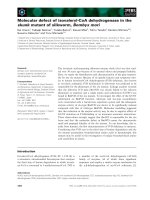
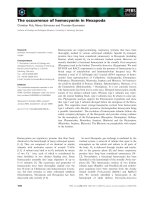
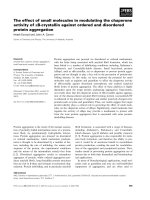
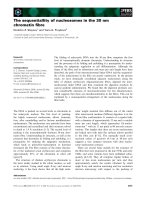
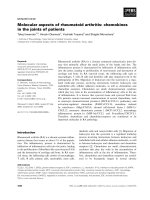
![Tài liệu Báo cáo khoa học: The stereochemistry of benzo[a]pyrene-2¢-deoxyguanosine adducts affects DNA methylation by SssI and HhaI DNA methyltransferases pptx](https://media.store123doc.com/images/document/14/br/gc/medium_Y97X8XlBli.jpg)
